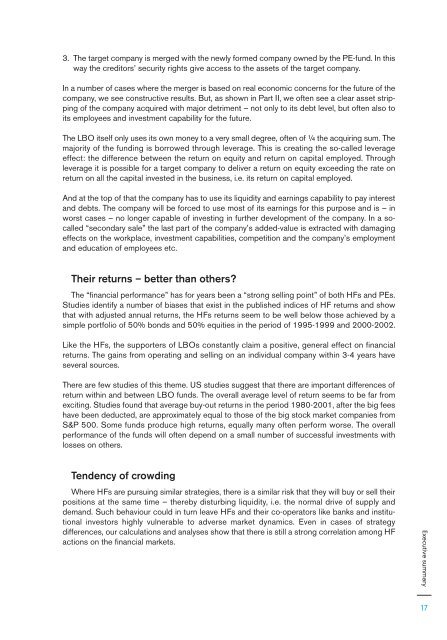Hedge funds and Private Equity - PES
Hedge funds and Private Equity - PES
Hedge funds and Private Equity - PES
Create successful ePaper yourself
Turn your PDF publications into a flip-book with our unique Google optimized e-Paper software.
3. The target company is merged with the newly formed company owned by the PE-fund. In this<br />
way the creditors’ security rights give access to the assets of the target company.<br />
In a number of cases where the merger is based on real economic concerns for the future of the<br />
company, we see constructive results. But, as shown in Part II, we often see a clear asset stripping<br />
of the company acquired with major detriment – not only to its debt level, but often also to<br />
its employees <strong>and</strong> investment capability for the future.<br />
The LBO itself only uses its own money to a very small degree, often of ¼ the acquiring sum. The<br />
majority of the funding is borrowed through leverage. This is creating the so-called leverage<br />
effect: the difference between the return on equity <strong>and</strong> return on capital employed. Through<br />
leverage it is possible for a target company to deliver a return on equity exceeding the rate on<br />
return on all the capital invested in the business, i.e. its return on capital employed.<br />
And at the top of that the company has to use its liquidity <strong>and</strong> earnings capability to pay interest<br />
<strong>and</strong> debts. The company will be forced to use most of its earnings for this purpose <strong>and</strong> is – in<br />
worst cases – no longer capable of investing in further development of the company. In a socalled<br />
“secondary sale” the last part of the company’s added-value is extracted with damaging<br />
effects on the workplace, investment capabilities, competition <strong>and</strong> the company’s employment<br />
<strong>and</strong> education of employees etc.<br />
Their returns – better than others?<br />
The “financial performance” has for years been a “strong selling point” of both HFs <strong>and</strong> PEs.<br />
Studies identify a number of biases that exist in the published indices of HF returns <strong>and</strong> show<br />
that with adjusted annual returns, the HFs returns seem to be well below those achieved by a<br />
simple portfolio of 50% bonds <strong>and</strong> 50% equities in the period of 1995-1999 <strong>and</strong> 2000-2002.<br />
Like the HFs, the supporters of LBOs constantly claim a positive, general effect on financial<br />
returns. The gains from operating <strong>and</strong> selling on an individual company within 3-4 years have<br />
several sources.<br />
There are few studies of this theme. US studies suggest that there are important differences of<br />
return within <strong>and</strong> between LBO <strong>funds</strong>. The overall average level of return seems to be far from<br />
exciting. Studies found that average buy-out returns in the period 1980-2001, after the big fees<br />
have been deducted, are approximately equal to those of the big stock market companies from<br />
S&P 500. Some <strong>funds</strong> produce high returns, equally many often perform worse. The overall<br />
performance of the <strong>funds</strong> will often depend on a small number of successful investments with<br />
losses on others.<br />
Tendency of crowding<br />
Where HFs are pursuing similar strategies, there is a similar risk that they will buy or sell their<br />
positions at the same time – thereby disturbing liquidity, i.e. the normal drive of supply <strong>and</strong><br />
dem<strong>and</strong>. Such behaviour could in turn leave HFs <strong>and</strong> their co-operators like banks <strong>and</strong> institutional<br />
investors highly vulnerable to adverse market dynamics. Even in cases of strategy<br />
differences, our calculations <strong>and</strong> analyses show that there is still a strong correlation among HF<br />
actions on the financial markets.<br />
Executive summary<br />
17




